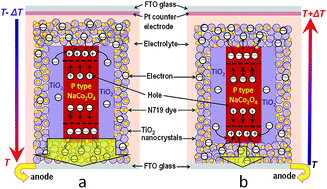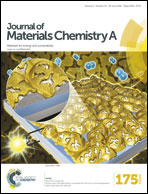Thermoelectric–photoelectric composite nanocables induced a larger efficiency in dye-sensitized solar cells†
Abstract
Multifunctional composite nanocables (CNCs) with a thermoelectric NaCo2O4 inner core and TiO2 outer shell were prepared by electrospinning and annealing, and further physically mixed with TiO2 nanocrystals to serve as photoanodes in dye-sensitized solar cells (DSSCs). A high power conversion efficiency (PCE) of 9.05% was obtained for the DSSC device with 10 wt% CNCs in the TiO2 photoanode, compared with 7.47% PCE for the DSSC with a pure TiO2 photoanode. The further performance improvement demonstrated with the thermoelectric–photoelectric CNCs was due to the inevitable temperature gradient between the two sides of working solar cells caused by irradiation differences on their two sides and the heating effect of sunlight irradiation. The temperature gradients of both −5 and +5 K were created and observed to lead to a significant increase to 10.07% and decrease to 7.76% of the PCE in the DSSC with 10 wt% CNCs, respectively. The difference was attributed to different directions of the thermoelectric electromotive force caused by different temperature gradients. This work not only is significant for developing novel photoanodes of DSSCs with high performance, but also provides an alternative to utilize multiple new energy technologies including photovoltaics and thermoelectricity for higher energy usage.


 Please wait while we load your content...
Please wait while we load your content...